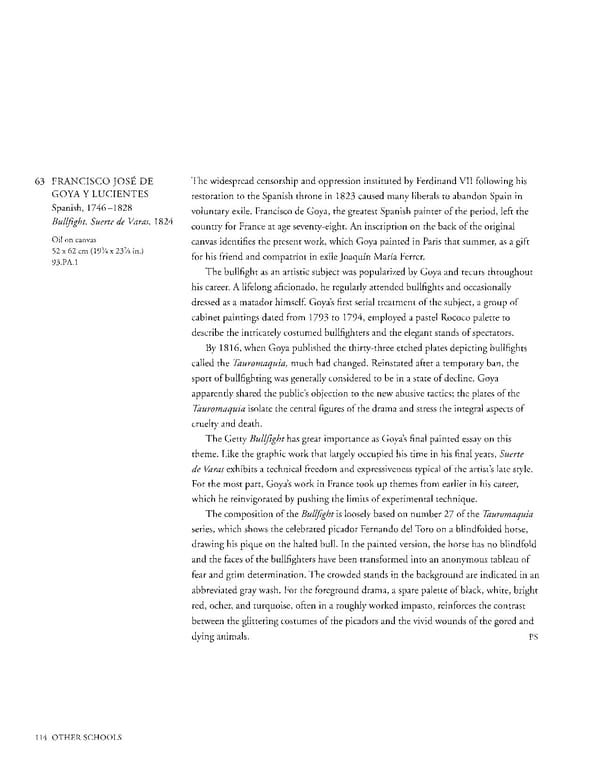63 FRANCISCO JOSE DE The widespread censorship and oppression instituted by Ferdinand VII following his GOYA Y LUCIENTES restoration to the Spanish throne in 1823 caused many liberals to abandon Spain in Spanish, 1746-1828 voluntary exile. Francisco de Goya, the greatest Spanish painter of the period, left the Bullfight, Suerte de Varas, 1824 country for France at age seventy-eight. An inscription on the back of the original Oil on canvas canvas identifies the present work, which Goya painted in Paris that summer, as a gift 52 x 62 cm(19¾ x 23 in.) for his friend and compatriot in exile Joaquin Maria Ferrer. 93.PA.1 The bullfight as an artistic subject was popularized by Goya and recurs throughout his career. A lifelong aficionado, he regularly attended bullfights and occasionally dressed as a matador himself. Goya's first serial treatment of the subject, a group of cabinet paintings dated from 1793 to 1794, employed a pastel Rococo palette to describe the intricately costumed bullfighters and the elegant stands of spectators. By 1816, when Goya published the thirty-three etched plates depicting bullfights called the Tauromaquia, much had changed. Reinstated after a temporary ban, the sport of bullfighting was generally considered to be in a state of decline. Goya apparently shared the public's objection to the new abusive tactics; the plates of the Tauromaquia isolate the central figures of the drama and stress the integral aspects of cruelty and death. The Getty Bullfight has great importance as Goya's final painted essay on this theme. Like the graphic work that largely occupied his time in his final years, Suerte de Varas exhibits a technical freedom and expressiveness typical of the artist's late style. For the most part, Goya's work in France took up themes from earlier in his career, which he reinvigorated by pushing the limits of experimental technique. The composition of the Bullfight is loosely based on number 27 of the Tauromaquia series, which shows the celebrared picador Fernando del Toro on a blindfolded horse, drawing his pique on the halted bull. In the painted version, the horse has no blindfold and the faces of the bullfighters have been transformed into an anonymous tableau of fear and grim determination. The crowded stands in the background are indicated in an abbreviated gray wash. For the foreground drama, a spare palette of black, white, bright red, ocher, and turquoise, often in a roughly worked impasto, reinforces the contrast between the glittering costumes of the picadors and the vivid wounds of the gored and dying animals. PS 114 OTHER SCHOOLS
 Masterpieces of the Getty Museum: Paintings Page 114 Page 116
Masterpieces of the Getty Museum: Paintings Page 114 Page 116